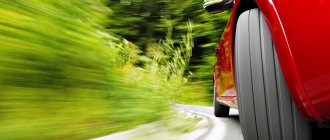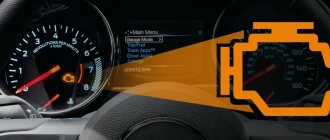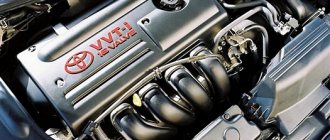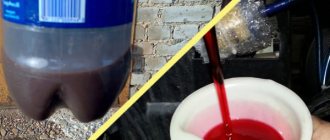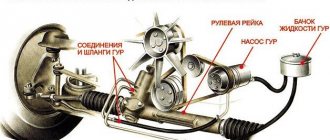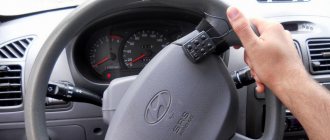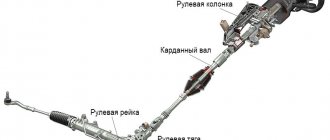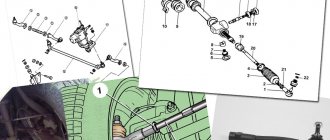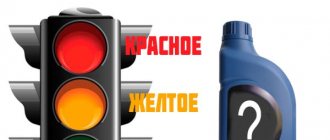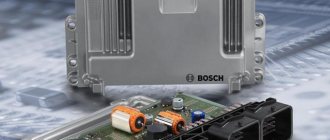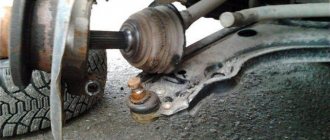If certain problems arise in the steering of your car, you should correct them immediately, otherwise delay may lead to the fact that the most important system of your car will malfunction and stop functioning normally. If it fails abruptly and directly while driving, then serious troubles in the form of loss of control and other not very successful consequences cannot be ruled out. A crunching sound when turning the steering wheel can mean several problems, each of which should be given special attention when diagnosing. Correcting it yourself or contacting a specialized service is up to you to decide. The car will definitely need good diagnostics, so the service in this case has many advantages.
A good service station will help you do a really good examination of each chassis and steering component in order to get reliable answers to the question of what caused the crunching noise. Turning the steering wheel affects more than just the steering rack. In this process, steering tips are included in the work, as well as rods that pull the elements of the chassis. Therefore, a knock or crunch in the steering wheel does not always mean problems with the steering mechanism. This may cause troubles associated with the chassis. Today we will look at the three most common problems that cause a crunching sound when turning the steering wheel.
CV joint is one of the likely culprits of steering wheel crunching
The steering mechanism does not often make sounds similar to a crunch, but for a CV joint this is the main indicator of a possible problem. Therefore, it is worth checking this particular breakdown first. If it crunches when turning while in motion, then in 90% of cases the culprit will be the CV joint, also called a grenade. This mechanism has a direct connection to the steering mechanism. When the steering wheel is turned to the maximum possible angle and a uniform, slow movement occurs when a grenade is broken, a crunching sound occurs, which intensifies over time. This problem can only be dealt with by replacement, which is quite difficult. The consequences of untimely repairs may be the following:
- gradual complete failure of the grenade and failure of this unit to perform its functions;
- When turning, the wheel begins to slip or slow down, depending on the nature of the breakdown;
- the crunch increases and no longer seems so harmless for the driver and passengers of the car;
- along with the crunching sound, a slight bouncing of the car appears when turning to the maximum degree;
- the thrust from the engine has every chance of simply flying out of the mount with the wheel, which will make further movement impossible;
- If a grenade suddenly falls out of its place, a load drop on the engine is possible.
You should not bring a breakdown to such a stage and check what can actually happen to the power unit. It is much better to simply eliminate the cause of the crunching and forget that such a problem was present. Few motorists have ever experienced what an overly neglected CV joint problem means, and reviews of this experience are not the most flattering. If, while turning, your car experiences a crunching sound in the steering area or on the wheels, you should simply replace the grenade with a new one. This is done at any service that services your brand of car.
Crunching with osteoarthritis
A constant, pronounced crunch, which is accompanied by pain, is a characteristic symptom of shoulder arthrosis. Unlike a similar disease that affects the knee or hip joint, arthrosis of the shoulder joint is most often secondary. That is, it develops not as an independent disease, but as a complication of other pathological processes.
Features of the pathology:
- develops mainly after 40 years;
- there is a restriction of not only active (initiated by the patient), but also passive movements in the joint (performed by the doctor);
- the history often includes a shoulder injury, repeated microtraumas, and a high level of physical activity (sports, heavy physical labor).
Arthrosis is diagnosed by X-ray examination. The doctor detects osteophytes along the lower edge of the articular surface of the humeral head. The joint space is narrowed. Possible cysts in bone tissue. There are signs of subchondral osteosclerosis.
The steering rack has a peculiar crunch and appears infrequently
Some BMW models in the late 90s had a certain technical subtlety - their steering racks sometimes crunched. It’s not even a breakdown, it’s just that the rack had such a design feature. However, the Bavarians never had a good relationship with slats. But this node is not the only one that causes certain problems. Problems with the steering rack occur in almost all cars; this unit lasts no more than 250-300 thousand kilometers. With such a resource, almost every car has to deal with rack problems. Moreover, in some cases the mechanism can fail much faster. The main signs of a broken steering rack are:
- The crunch may occur during the entire stroke of the steering wheel or at certain intervals during rotation;
- knocks are heard not just under the hood of the car, but directly in the steering wheel, vibration is felt in the hands;
- with the engine turned off, when checking the free play of the steering wheel, a knock is heard in the extreme positions;
- the characteristics of the steering change, stiffness appears or, conversely, excessive ease in turning the steering wheel;
- There are problems in driving; the car does not always react to turning the steering wheel as expected.
If such problems exist in your car, you should work on the steering rack. Unfortunately, the design of the steering mechanism on modern cars is such that in most cases the rack will have to be replaced. This is an important point that should be applied almost always. Steering rack repair is short-lived, so it may not be economically viable and not very pleasant for further use. It is best to change the rack, and it may not be possible to do it yourself in a garage, especially on cars with power steering and other additions to the controls.
Elimination of crunches and knocks, restoring the operation of CV joints
How to find out which CV joint is crunching - we figured it out, now about the measures that should be taken to fix the problem, since it is undesirable to operate a car with problematic joints.
One of the disadvantages of CV joints is their non-repairability, that is, if the joint crunches, then it is worn out and requires replacement. The only thing that can be done is to “extend the life” of the node and delay its replacement.
Since the main reason for the appearance of crunches is dust and dirt, when they appear, you should immediately inspect all the anthers for damage. If none are found, we determine which CV joint is crunching using one of the above methods.
After identifying the problematic hinge, we try to extend its service life. To do this you need:
- Remove the drive from the car;
- Disassemble the CV joint;
- Thoroughly wash all components with gasoline, solvent or other means (white spirit, etc.);
- Apply new CV joint grease or equivalents (see above) and assemble the hinge;
- Install a new boot;
- Install the rebuilt drive on the car.
At the initial stage of wear, these measures are enough to get rid of the crunches, but they will eventually return (when the wear intensifies) and then the hinge will have to be replaced.
Chassis, bearings and other rare crunching options
When you check all the possible causes of the crunching noise when turning, you can safely say that the problem lies only in the chassis. Of course, finding chassis problems is quite difficult; for this, it is also better to use professional diagnostics. Crunching is the prerogative of bearings, but the only type of this element in the chassis that can crunch is the wheel bearing. However, they often buzz when they fail at a certain speed rather than crunch. If you want to diagnose wheel bearings, you can do it as follows:
- lift one side of the front of the car on a jack and secure the car well with stands;
- put the car on the handbrake, and also make sure that the three wheels are firmly on the base;
- sit behind the wheel or have your assistant sit down so that he performs certain actions to spin the wheel;
- after this you need to start the car, turn on second speed and smoothly release the clutch pedal, giving a little gas;
- Please note that such actions cannot be carried out on vehicles with all-wheel drive and a locked center differential;
- after this, you need to turn off the engine and allow the wheel to spin at a fairly high speed;
- if the bearing on this wheel is faulty, it will definitely tell you about it with an abundant hum;
- If the bearing is in good condition, only the sound of friction of the metal parts of the suspension will be heard.
This is a fairly simple way to diagnose wheel bearings and will not require too much time. To implement such a test, it is not necessary to have an assistant; you can carry out all the tests yourself. To do this, you need to quickly get out of the car while the wheel is spinning. The best noise from broken bearings is heard near the wheel. However, sometimes wheel bearings make a noise throughout the garage, then it’s better to replace them before it’s too late. Completely disintegrated wheel bearings will cause serious problems throughout the entire chassis. Therefore, it is worth paying special attention to correcting problems if any. We invite you to watch a short video describing the cause and elimination of the problem with knocking and crunching when turning the steering wheel:
radiography
radiography
Diagnostic methods:
- radiography;
- if the diagnosis is unclear - magnetic resonance imaging.
The doctor also uses clinical methods. He will check in what positions of the shoulder the crunch appears, at what range of motion the pain occurs, and how intense the load the patient can bear. When determining the causes of a crunch in the shoulder joint, the doctor pays attention to the patient’s age, since different diseases are characteristic of people of different age categories. For persons under 40 years of age, dislocations and subluxations of the shoulder are common. In older patients, the risk of chronic diseases of the rotator cuff muscles, as well as arthrosis, increases.
Let's sum it up
If you think that a crunching sound when turning the steering wheel is not such a serious problem, find out the opinions of those drivers who have encountered its consequences due to poor-quality repairs or no restoration at all. After a detailed study of the problem, it turns out that you are not getting the best operating conditions for the car, and if you wait and do not repair the car, you are even exposing yourself to a certain danger. It is best to immediately find the cause of the crunching and completely correct it.
In this case, we are often talking about the safety of the trip, so the best option would be to go to a professional service station and solve all problems by installing factory spare parts. A crunching sound always means that a specific control, chassis, or other components have broken down. Therefore, do not think that this manifestation will go away by itself. Just keep yourself safe and gain more confidence on every trip. What problems have you experienced that resulted in a crunching sound in the steering area?
Physiological crunch
Physiological crunch
- joint pain;
- limited mobility;
- swelling;
- redness;
- deformation.
If the joint clicks, it is likely that this is due to gas bubbles that burst when the joint capsule is stretched. These sounds are not accompanied by pain. They do not signal illness.
Sometimes the crunch is caused by friction inside the joint. This may be friction of joint surfaces, muscles, tendons. The stability of the shoulder is achieved by the abundance of soft tissues that support it. If they become inflamed and increase in volume, then friction appears. It causes discomfort and is often accompanied by characteristic sounds.
How to identify a crisp CV joint
Finding out which “grenade” crunches is quite simple. First of all, you need to understand that the characteristic crunching or creaking noise when turning is produced by the outer CV joint. The inner joint may make a clicking noise on a straight road. We will touch on diagnostic algorithms below.
The crunching sound of the outer CV joint usually occurs when the driver turns with the wheels fully or strongly turned (in their direction). This is especially audible if you also “give on the gas” at this time. At this moment, the hinge experiences maximum or close to this load, and if it is faulty, then the mentioned sounds occur. Externally, this may manifest itself in the fact that you will feel “kickback” in the steering wheel when turning.
As for internal CV joints , their failure is more difficult to diagnose. Usually a similar sound comes from them when driving on an uneven road, and the deeper the holes the wheel gets into, the greater the load the joint experiences, and accordingly, the more it crunches. In some cases, a malfunction of the internal CV joint is diagnosed by vibration and “twitching” of the car during acceleration and at high speeds (about 100 km/h or more). Even when driving on a straight and level road (symptoms resemble a situation when the wheels are not balanced).
Next, let's move on to answering the question of how to determine which CV joint is crunching, internal or external. There are several verification algorithms. Let's start with the outer hinges.
Common causes of squeaking noise when turning the steering wheel
Here are the most common reasons why you hear a squeak when turning the steering wheel.
Improperly executed
If you hear squeaking noises from your tires, and it mostly happens when the car is stationary, there is a good chance that the problem is due to improper wheel alignment. In this case, it is necessary to perform a wheel alignment as quickly as possible to correct the problem.
Incorrect wheel alignment angles negatively affect the tires, which begin to wear unevenly and fail much faster than they should.
Silent blocks creak
A common problem that is often encountered in hot weather. If silent blocks begin to creak at high ambient temperatures, this is the first “bell” that they will soon fail.
The creaking of silent blocks in hot weather is due to their drying out. Since the main working material of silent blocks is rubber, at high temperatures it “dries out” and decreases in size, especially if we are talking about relatively old parts.
There is no danger in the creaking of silent blocks until the part breaks. Remove the silent blocks and carefully inspect them for cracks and various types of damage. If there are no visible problems, you can put them in place and continue driving, hoping that soon the air temperature will drop lower and the squeak will disappear.
Please note: For many modern cars you can find silent blocks made of polyurethane, which is not subject to the problem of “drying out” in the heat.
Bearings squeak
If you hear a squeaking, squeaking, or crackling sound from the steering knuckle when you turn the steering wheel, this most likely indicates a bearing problem. They behave in a similar way if there is not enough lubrication for their proper operation or if there is sand (or other foreign element) in the bearing.
Bearing creaking must be eliminated as quickly as possible so that the part does not fail completely. To do this, remove the bearing and inspect it for damage. If they are not found, then lubricate the part, install it in place and adjust.
Please note: When the squeaking of a bearing is caused by foreign elements entering it, be sure to find the reason for their entry into the part.
Steering rack or steering column creaks
It is quite simple to determine the creaking of the steering column by the characteristic vibration, which will also occur when the steering wheel rotates. Most often, the steering column clutch squeaks, and this problem is typical for cars that were unsuccessfully restored after a serious accident. This problem, if the noise is not strong, does not affect the quality of the steering mechanism, so you can continue to operate the car. The situation can only be corrected by replacing the steering column.
Also, a squeak can be heard from the steering rack and column joint if they are poorly adjusted or there is severe wear. Depending on the car model, this problem can be solved in different ways. Most often it is possible to adjust the mechanism.
Tie rod ends squeak
Due to damage to the anthers, foreign elements get into the tie rod end pin, which leads to squeaks both when turning the steering wheel and when overcoming obstacles. To determine if there is a problem, you need to inspect the tips, and if sand or other foreign matter actually got into them, you will need to replace them, and it is recommended to change them in pairs.
The plastic casing creaks
Every driver knows that when actively using a car that is not of the best build, “crickets” will appear over time. They represent creaks of the front panel, including the steering casing, made of plastic. This problem is solved in various ways, depending on the car model.
If all the parts described above have been inspected and the cause of the squeak cannot be determined, it is also recommended to check the power steering drive belt and brake elements, especially the pads and discs.
This often happens when one or another problem occurs in the car. Extraneous sounds in the car from the steering system should immediately be perceived by the driver as a threat to his safety and other road users. It is important not to delay contacting auto mechanics. It will also not be superfluous to conduct computer diagnostics, which will help determine one or another malfunction of the car.
A creaking sound in the steering wheel is a possible sign of serious problems.
Extraneous sounds from the steering system can occur in various situations. It is important to take into account the complexity of the steering mechanism, especially when it works with hydraulic or electric power steering. The presence of these elements increases the number of causes of noise when turning the steering wheel. For high-quality diagnostics, it is necessary to attract a highly qualified specialist who must clearly determine the place from which the extraneous noise is coming. It is important to tell the mechanic under what circumstances the noise occurs - while driving or at a standstill.
You also need to describe the frequency of the squeak, when you turn the steering wheel in which direction it gets stronger, and whether it is related to the road surface, cold or hot weather.
Why does the steering wheel squeak when turning?
Extraneous noise when turning the steering wheel may be caused by faults in the steering, braking system, suspension or chassis.
The most common breakdowns are the steering column and steering rack.
If the first one malfunctions, you can feel superficial but noticeable vibrations and impacts on the steering wheel. It may begin to make sounds when it hits the steering wheel during braking or an accident. In this case, there is a risk of bending the steering column. Extraneous sounds may come from the steering column coupling.
You can eliminate the noise by adding some lubricant. In addition, it is worth paying attention to the steering column cross. The driveshaft should be treated with a small amount of reliable WD-40 lubricant.
The best solution to all problems is to purchase and install a new steering column.
The steering wheel creaks when turning due to the steering rack
The steering rack may have the following problems:
- Wear of parts and mechanisms;
- Rupture of anthers and dirt getting onto the rail;
- Friction of steering tips on rods;
- Deformation of the steering rack housing.
Extraneous sounds can also come from the junction of the steering column and rack. To do this, you need to properly adjust them. This adjustment may vary on different car models.
Why else does creaking occur when turning the steering wheel in place?
A car's steering wheel creaking can occur when the tie rod boots are damaged. Moreover, an extraneous sound is produced almost always: during turns in place, while driving and overcoming uneven road surfaces. Debris that gets into them contributes to the occurrence of squeaking. Therefore, it is necessary to inspect the condition of the anthers and replace them if worn.
If the steering wheel not only creaks when rotating, but also plays and vibrates, this may indicate wear on the steering joints that need to be replaced.
The next reason that the steering wheel squeaks when turning is a lack of power steering fluid. Usually the creaking appears when turning while stopping - extraneous noise is heard. In order to solve this problem, you should add fluid to the power steering reservoir yourself. If an extraneous squeak remains, then you should pay attention to the power steering pump and belt; they may be faulty. It is recommended to repair power steering parts at specialized service stations.
Another answer to the car owner’s question “what can squeak when turning the steering wheel?” is incorrect wheel alignment. It can be done in service centers with special equipment and computers. This will allow you to set the most accurate wheel alignment angles. Incorrect wheel alignment can have such bad consequences as accelerated and uneven tire wear. A dangerous call can be a characteristic crunch and squeak when turning the steering wheel of a car while it is moving.
This may indicate wear of the ball joints, which need to be properly diagnosed and immediately replaced in the event of a malfunction. A worn ball joint can cause a wheel to come off at high speed, putting the vehicle and driver at increased risk.
Also, a sound when turning the steering wheel is produced when the support bearing of the strut wears out (pictured above). A temporary solution to this problem is lubrication. To do this, you need to dismantle the bearings, inspect them for the presence of sand and other dirt and damage. If there are no problems with the bearing, then you just need to lubricate it and install it back and adjust it correctly. But a more reliable option is to replace the bearings with new ones.
Cars with front-wheel drive or all-wheel drive experience noise when turning the steering wheel when their constant velocity joints (CV joints) wear out. The sharper the turn and the higher the speed, the louder the noise. If crunching sounds are made at the slightest turns of the steering wheel, then spare parts should be changed immediately.
In hot weather, when turning the steering wheel, silent blocks may begin to creak. High air temperature promotes drying and shrinkage of rubber silent blocks. A visual inspection by dismantling will allow you to assess the nature of their wear. Polyurethane can be a good alternative to rubber silent blocks. It does not deform when exposed to elevated air temperatures. A grinding noise in the steering wheel can also occur when braking. The problem lies in a malfunction of the brake system, namely worn pads. Installing new brake pads will solve this problem.
In addition, you need to pay attention to the condition of the brake discs.
Extraneous noise can also arise from the interior trim, i.e. steering casing, which is made of plastic. In inexpensive cars of modest configuration there is a tendency to the so-called. crickets. The solution to this problem depends on the make and model of the car. From this video you will learn how to solve the problem of squeaking steering wheel due to the upper support bearing:
– How does sedentary work or computer work affect shoulder pain?
– There are no direct negative effects, however, due to low muscle tone, a similar syndrome can develop. Physical exercise is the best preventative measure, and in case of illness, one of the treatment methods.
– When should you be concerned about your condition and when should you see a doctor?
– Excruciating pain is, unfortunately, the main reason why a patient consults an orthopedic traumatologist. Not much attention has been paid to snapping shoulder syndrome. It is often simply not diagnosed because there is not enough knowledge about it. This disease cannot be recognized not only by general practitioners, but also by some specialists. If the pain is not severe, the patient simply gets tired of visiting doctors. Without receiving a proper answer as to what is happening to him, why the pain does not go away, he often resigns himself and adapts to the discomfort until he loses his ability to work.
Cases are different. For example, after a successful operation, one patient comes to me for a follow-up examination and asks if he can bring his brother to me, who has also been having pain and cracking in his shoulder for a long time? After we performed the operation on the patient’s brother, he, in turn, brings in a third one, who needed as many as three operations - he had branched bone growths on both shoulder blades and a rib. After all three were healthy and happy with the result, I jokingly asked if there were any other brothers in the family suffering from a similar syndrome? The brothers smiled and replied that they had a sister, fortunately, she was healthy.
Video - what to do if the steering wheel crunches
About knocking noises in the wheel when turning the steering wheel while driving
In conclusion of our article, we draw the readers’ attention to some nuances, knowledge of which will allow you to make the most efficient use of the service life of the replaced hinges:
- Replace the hub nut with a new one whose edge is securely locked.
- During installation of the internal CV joint, a special plastic plug is installed at the end of the shaft.
- Before installing the hinges, fill them with a sufficient amount of CV joint-4 lubricant.
- Experts recommend replacing the retaining ring with a new one before installing the mechanism on the car.
- When installing the drive into the gearbox, check the fit (with full fixation) of the side gear. You can use a hammer and a wooden tool for this process.
